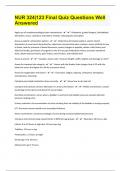NUR 324|123 Final Quiz Questions Well
Answered
Apply use of nonpharmacological pain interventions - ✔ ✔ Relaxation, guided imagery, biofeedback,
distraction, music, cutaneous stimulation, herbals, reducing pain perception
Assess a patient's elimination pattern - ✔ ✔ Determine elimination pattern, ask for client's
description of usual stool characteristics, determine normal elimination routines, assess artificial aid use
at home, look for presence of bowel diversions, assess changes in appetite, obtain a diet history and
daily fluid intake, get history of surgeries in the GI tract, get medication history, ascertain emotional
state, obtain exercise history, pain history, social history, and mobility level
Assess a wound - ✔ ✔ Visualize, assess color, measure (length, width, depth), any drainage or odor?
Assess for impaired skin integrity - ✔ ✔ Assess with the Braden Scale (ranges from 6-23 with the
lower the score, the higher the risk for a pressure ulcer)
Assess for oxygenation risk factors - ✔ ✔ Chest pain, fatigue, dyspnea, orthopnea, hemoptysis,
hematemesis, wheezing
Calculate prescribed medication doses correctly - ✔ ✔ Know how to do med cal!
Compare and contrast common alterations in urinary elimination - ✔ ✔ Reflex incontinence: caused
by damage to the spinal cord above the sacral region
Overflow incontinence: occurs when a bladder is overly full and bladder pressure exceeds sphincter
pressure, leaking urine
Urinary retention: the accumulation of urine resulting from an inability of the bladder to empty properly
UTI: the most common health care-associated infection
Stress incontinence: involuntary leakage of urine during increased abdominal pressure
Compare and contrast sleep requirements of different age groups - ✔ ✔ Neonates: 16 hours a day
Infants: 8 to 10 hours at night but 15 hours per day
Toddlers: 12 hours a day
Preschoolers: 12 hours at night
School age: 9 to 10 hours
Adolescents: get 7.5 hours
,Young adults: get 8-8.5 hours
Middle/Older adults: total number of hours decline
Compare and contrast the roles of the prescriber, the pharmacist, and the nurse in medication
administration - ✔ ✔ MD/NP/PA prescribes the medication, the RN checks the order and it is sent to
the pharmacy, the pharmacist prepares the medication and sends it to the nursing unit, then the RN
administers the medication to the patient
Comprehend nutritional impact of micronutrients - ✔ ✔ Vitamins: essential for metabolism and are
either water-soluble or fat-soluble
Minerals: catalysts for enzymatic reactions and are either macrominerals or trace elements
Correctly and safely prepare and administer medications - ✔ ✔ Check at least 2 patient identifiers,
give oral meds in a medicine cup, do not leave medication unattended, do not give meds you did not
prepare, hold liquid bottle with label against palm when pouring, measure to the meniscus at eye level,
position patient upright to swallow and ascertain that the medication has been consumed, wear gloves
with topical medications, use Semi-Fowler's for enteral meds, never recap a used needle, know the
various injection techniques,
Define immobility and explain why clients become immobile - ✔ ✔ Immobility is the inability to
move about freely, and it could result from older age, dementia, surgery recovery, injury recovery,
illness recovery, neurologic problems, weakness, or poor balance
Demonstrate postoperative exercises - ✔ ✔ Promote ambulation unless contraindicated, assess
movement of extremities, use TED/SCD or leg exercises
Describe anthropometric measurements - ✔ ✔ Anthropometry: measurement system of the size
and makeup of the body
Examples: height and weight, ideal body weight (IBW), and body mass index (BMI)
Describe changes in mobility status across the lifespan - ✔ ✔ Infants/Toddlers/Preschoolers:
Musculoskeletal development during growth allows support of weight for standing and walking; body
weight is not distributed evenly so falls occur often
Adolescents: Tremendous increase in growth requires more mobility to develop muscles
Adults: correct posture and alignment help adults feel and look good and confident, all of the
coordination to perform ADLs has developed
Older adults: bone mass loss occurs due to decreased physical activity, hormonal changes, and bone
resorption, they walk slower, take smaller steps, and appear less coordinated
, Describe characteristics of normal and abnormal urine - ✔ ✔ Color: pale straw color to amber
(bleeding from kidney would be dark red and bleeding from bladder would be bright red)
Clarity: normal urine appears transparent and could be cloudy from WBCs, bacteria, or renal disease
Odor: the more concentrated the urine, the stronger the odor
Describe clinical applications of relaxation therapies - ✔ ✔ Lowers heart rate and blood pressure and
decreases muscle tension
Progressive or passive relaxation to reduce stress response
Describe common alterations in elimination - ✔ ✔ Constipation, impaction, diarrhea, incontinence,
flatulence, hemorrhoids
Describe common disturbances in fluid, electrolyte, and acid-base balance - ✔ ✔ Fluid volume deficit
Fluid volume overload
Imbalance of electrolytes
Respiratory acidosis (too much CO2)
Respiratory alkalosis (hyperventilation)
Metabolic acidosis (bicarbonate loss or increase of metabolic acids)
Metabolic alkalosis (excessive bicarbonate from antacids or deficient acids from losses)
Describe components of pain assessment - ✔ ✔ Onset and duration, location, intensity, quality,
pattern, relief measures, contributing symptoms, effects of pain on the patient
Describe conditions that can be adjusted to promote meaningful sensory stimulation - ✔ ✔ Orient to
the environment, communicate, control sensory stimulation, perform safety measures, maintain healthy
lifestyle, understand and educated about sensory loss, provide socialization, promote self-care
Describe differences between nursing care of acute and chronic wounds - ✔ ✔ Acute care proceeds
through an orderly reparative process (i.e. surgical incision or laceration
Chronic wound fail to follow an orderly or timely process (i.e. diabetes related vascular insufficiency)
All wound care involves preventing and managing infections, cleansing the wound, removing nonviable
tissue, managing exudate, maintaining the wound in a moist environment, and protecting the wound
Should always document the date/time, dressing type, location, appearance of wound, drainage, and
odor




